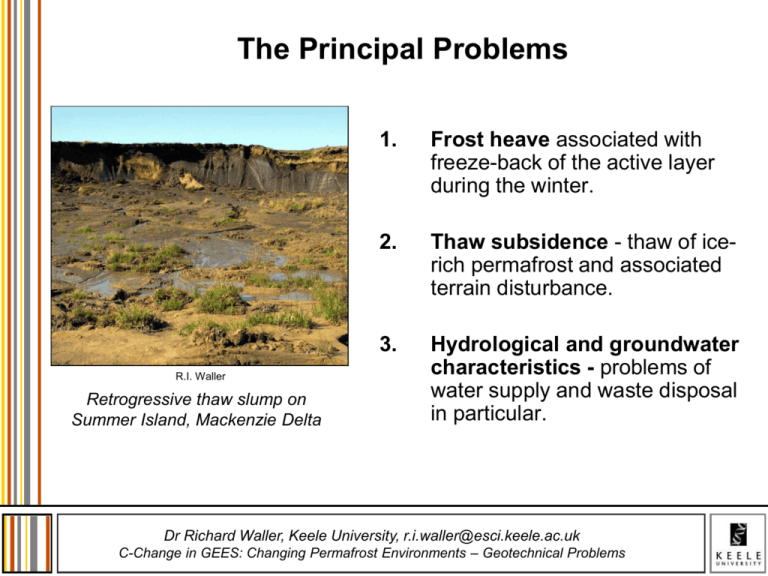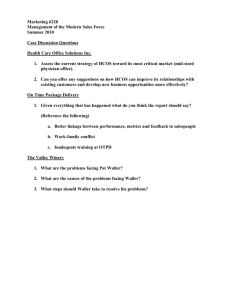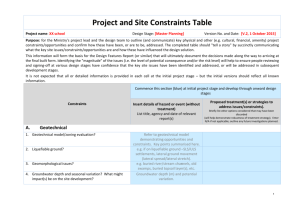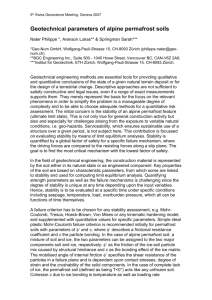Changing Permafrost Environments – Geotechnical Problems
advertisement

The Principal Problems R.I. Waller Retrogressive thaw slump on Summer Island, Mackenzie Delta 1. Frost heave associated with freeze-back of the active layer during the winter. 2. Thaw subsidence - thaw of icerich permafrost and associated terrain disturbance. 3. Hydrological and groundwater characteristics - problems of water supply and waste disposal in particular. Dr Richard Waller, Keele University, r.i.waller@esci.keele.ac.uk C-Change in GEES: Changing Permafrost Environments – Geotechnical Problems Thermal Disturbance Major construction problem, which relates to the thermal sensitivity of permafrost. Modification of the ground thermal regime can lead to two problems: 1) Thaw subsidence: ground warming; increase in depth of active layer. R.I. Waller 2) Frost heave: can occur seasonally (within active layer) or more permanently (permafrost aggradation). N.B. Only a problem where material is frost susceptible and resulting frozen ground is ice-rich. Dr Richard Waller, Keele University, r.i.waller@esci.keele.ac.uk C-Change in GEES: Changing Permafrost Environments – Geotechnical Problems Surface boundary conditions CLIMATE GROUND SURFACE TEMP. Surface energy balance GROUND THERMAL REGIME Ground thermal properties (+time) Human activities cause problems by changing the surface boundary conditions and modifying the surface energy balance. PERMAFROST THICKNESS Dr Richard Waller, Keele University, r.i.waller@esci.keele.ac.uk C-Change in GEES: Changing Permafrost Environments – Geotechnical Problems Thaw Subsidence • Disturbance of surface boundary conditions usually results in an increase in surface temperatures and thermokarst development. • Common causes: – Disturbance or clearance of vegetation Associated loss of surface insulation. – Construction of heated building. – Stripping of surface materials: e.g. to supply construction materials. – Movement of vehicles: seismic lines from 1950s still visible in ice-rich tundra regions. Dr Richard Waller, Keele University, r.i.waller@esci.keele.ac.uk C-Change in GEES: Changing Permafrost Environments – Geotechnical Problems Dawson City was the first city to be built on ice-rich permafrost in 1898 Construction of heated buildings had inevitable consequences... http://www.flickr.com/photos/travfotos/249343703/ Dr Richard Waller, Keele University, r.i.waller@esci.keele.ac.uk C-Change in GEES: Changing Permafrost Environments – Geotechnical Problems Stripping of Surface Materials Case Study: Banks Island http://www.nasa.gov/centers/ames/images/content/173629main_dryvalleys4-hires.jpg Thaw lakes on Banks Island • Relates to construction of an airstrip between 1959-62. • Thawed surface gravels were stripped and moved by bulldozer to provide a level runway. • Subsequent thaw of underlying icerich sands with 20-35% volumetric excess ice content (and ice wedges). • Development of hummocky thermokarst terrain and widespread landscape disturbance. French, H.M. (1975) Man-induced thermokarst, Sachs Harbour Airstrip, Banks Island, Northwest Territories. Canadian Journal of Earth Sciences, 12, 132-144. Dr Richard Waller, Keele University, r.i.waller@esci.keele.ac.uk C-Change in GEES: Changing Permafrost Environments – Geotechnical Problems Human activities (e.g. shading associated with unheated buildings) can also result in a reduction in ground temperature and problems associated with long-term frost heave… Surface frost heave associated with the growth of needle ice (R I Waller) Dr Richard Waller, Keele University, r.i.waller@esci.keele.ac.uk C-Change in GEES: Changing Permafrost Environments – Geotechnical Problems Controlling Factors • Three factors determine the potential severity of permafrost degradation: – Ice content of the permafrost (notably presence/absence of excess ice). – Thickness and insulating qualities of the surface vegetation. – Duration and warmth of the summer thaw period. R.I. Waller Must be considered when assessing the risk and planning remedial measures. Dr Richard Waller, Keele University, r.i.waller@esci.keele.ac.uk C-Change in GEES: Changing Permafrost Environments – Geotechnical Problems Gravel Pads • Most common solution is to build structure on a pad of coarsegrained sediment. • Physically separates structure from the permafrost. • Coarse-grained material is nonfrost susceptible - limits frost heave. R.I. Waller Heated fuel oil tank resting on a ventilated, gravel pad. Inuvik, Canadian N.W.T. • Commonly used in construction of roads, airstrips, buildings etc. • Needs careful design – aim to provide insulation equivalent to pre-existing surface materials. Dr Richard Waller, Keele University, r.i.waller@esci.keele.ac.uk C-Change in GEES: Changing Permafrost Environments – Geotechnical Problems Gravel Pad Design If too thin (a): level of insulation will be reduced, seasonal temperature fluctuations will increase, and active layer will deepen, causing subsidence. If too thick (b): level of insulation is increased, fluctuations will decrease and active layer will thin, leading to frost heave. Figure from: French, H.M. 2007. The Periglacial Environment (3rd ed.). Wiley & Sons, Chichester. © Wiley and Sons Dr Richard Waller, Keele University, r.i.waller@esci.keele.ac.uk C-Change in GEES: Changing Permafrost Environments – Geotechnical Problems Additional Solutions R.I. Waller Houses in Nuiqsut (Alaska) built on wooden piles • Piles: If structure is likely to generate large amounts of heat, whole structure is usually mounted on piles driven into the permafrost. – Allows circulation of air and greater physical separation. • Thermosyphons: Passive heat pumps can be used to enhance the degree of cooling. Used in important structures such as dams. Dr Richard Waller, Keele University, r.i.waller@esci.keele.ac.uk C-Change in GEES: Changing Permafrost Environments – Geotechnical Problems Thermosyphons R.I. Waller Thermosyphons providing additional cooling around a fuel oil tank • Passive heat pumps used to enhance cooling of foundations. • Sealed pipe containing a volatile fluid that transfers heat in response to a thermal gradient (e.g. Ammonia, pressurised CO2). • Two parts: – Evaporator (buried in ground). – Condensor (above ground). • When evaporator (ground) is warmer than the condensor (air): – Fluid evaporates (removes heat). – Rises into the condensor and condenses (releases heat). – Sinks back into the evaporator. Dr Richard Waller, Keele University, r.i.waller@esci.keele.ac.uk C-Change in GEES: Changing Permafrost Environments – Geotechnical Problems Water Supply and Waste Disposal Utilidor and “utilidettes” in Inuvik, Canadian NWT (R.I. Waller) Dr Richard Waller, Keele University, r.i.waller@esci.keele.ac.uk C-Change in GEES: Changing Permafrost Environments – Geotechnical Problems Contents •Introduction •Site investigation •Site considerations •Considerations for the foundations •Earth structures •Buried structures •Monitoring of geotechnical parameters 14 Siting process • Regional analysis High level review of an area where there is an interest to build a nuclear power plant to identify some potential sites. This is largely based on excluding areas that do not meet some high level criteria such as adequate water supplies or seismic stability. Potential sites (sites within the area of interest not ruled out by the regional analysis) This analysis shall be conducted as much as possible on the basis of existing data without engaging important survey means (mainly for confidentiality reasons). • Screening analysis / Site selection Reduce the number of potential sites to a few (less than 10) candidate sites that can then be analyzed in detail. This involves either further exclusion criteria or very simple assessment to identify those sites that are most likely to provide a suitable site. The sites from this step are called candidate sites. Candidate sites (a list of less than 10 sites that appear suitable and can be ranked ). • Ranking analysis /Site selection 15 final step of the process Selection Stage The investigation at the site selection stage is to determine the suitability of candidate sites. On the basis of the above mentioned information on subsurface conditions, the potential or candidate sites can be ranked according to the suitability of the foundation. •Unacceptable subsurface conditions. •Groundwater regime. –A site with geological conditions that could affect the safety of a nuclear The hydrogeological maybeallow an estimate of theof groundwater location power plant andliterature that cannot corrected by means a geotechnical •Classification of sites. and regime (seeorIAEA Safety Series No.50-SG-S6). treatment compensated for by constructive measures is unacceptable. A siteGeological may be classified as a rock site, rock orvolcanic stiff soilactivity, site, soft soil site, hazards such as surfacesoft faulting, landslides, or a combination .processes, The soil type is further and divided into adue non-cohesive and •Foundation conditions. permafrost, thereof erosion subsidence collapse to underground cohesive soil. The type of soil, depth to bedrock and the properties of the deposit may be cavities inferred. This allows a preliminary selection of acceptable foundation types to be made. 16 Verification Stage In this stage, the investigation programme should cover the site as a whole as well as a smaller scale appropriate for layout considerations • Geological hazards, geological and subsurface conditions • Liquefaction potential • Feasible foundation types (preliminary bearing capacity and foundation stability, preliminary settlement ranges • Groundwater levels and regime • Site preparation requirements (earthworks, excavations…) • Site investigation techniques used at this stage – – – – Seismic refraction and reflection survey Rotary borehole drilling In situ mechanical testing Laboratory testing 17 Confirmation stage • In this stage, preliminary plant characteristics such as the loads, the physical dimensions of the buildings, preliminary structural engineering criteria and the preferred plant layout are know • In this stage, sufficient in situ and laboratory testing should be conducted to allow the estimation of the bearing capacity, determination of settlements of structure and the site amplification of seismic waves, establishment of soil– structure interaction parameters (dynamic and static), evaluation of the liquefaction potential and evaluation of a site specific design response spectrum, if required. • As a minimum, the following indicators of potential cavities and susceptibility to ground collapse should be considered: – Sinks, sink ponds, caves and caverns, sinking streams, historical 18 ground subsidence, mines, surface depressions, Rock types such Before operation of NPP • Pre-operational stage : complete and refine the assessment of site characteristics by incorporating geotechnical data newly obtained during foundation excavation and construction. • Operational Stage : • settlement of structures should be measured and used to confirm its safety and integrity by comparing with prediction analyses , • level of the water table, should be measured and compared with predictions to enable an updated safety assessment to be made 19 ETC-C part2 20 Sources of Data • Historical and current documents – maps (topographic, geological, geophysical,soil…) – geotechnical reports and other geotechnical literature – earth satellite imagery – aerial photographs water well reports and water supply reports – oil and gas well records – hydrogeologic maps, hydrologic and tidal data, flood, climate and rainfall records – mining history, old mine plans and subsidence records – seismic data and historical earthquake records – newspaper accounts of events of significance – records of performance of structures in the vicinity. • In situ investigation tests • Laboratory tests 21 Geophysical in situ tests Nature of materials Cross hole seismic test Gravel to cohesive Uphole/downhole seismic test Electrical resisitivity Gravel to cohesive Nuclear logging Gravel to cohesive Gravel to cohesive Surface seismic All types investigation Microgravimetry All types Ground Radar Acoustic Penetrating All types Magnetic technics All types All types Parameters measured Shear wave velocity Shear wave velocity Porosity and water content Water content Types of problems Commentaries Site categorization, SSI Site categorization, SSI Internal erosion 1 hole instead of 2 holes Using of logging Surface wave velocity Acceleration due to gravity Speed of propagation Speed of propagation Magnetic field intensity Site categorization Sinkholes, heterogeneities Cavities Subsurface complex Damaged zones Dikes and dams maintenance Dikes and dams maintenance 22 Areas of humidity Subsurface complex What is geophysics ? • Seismology - Study of natural [from earthquakes] and maninduced seismic waves • Gravity - Study of variations in earth's gravitational field • Electrical Methods - Use of electrical conductivity / resistance of earth • Electromagnetics - Study of induced electromagnetic fields • Magnetics - Analysis of variations in earth's magnetic field 23 Field Tests to Measure Seismic Wave Velocities 24 Geotechnical in situ tests Nature of materials Flat jack test Rock Hydraulic fracturing test Rock Direct shear stress test Rock Plate bearing tests Clay, sand, gravel Pressure meter test Static penetrometer test Dynamic penetrometer test Vane shear test Parameters measured In situ normal stress In situ stress state Shear strength Reaction modulus Clay, sand, gravel Elasticity modulus Compressibility Clay, sand, gravel Cone resistance Clay, sand, gravel Cone resistance Relative density Cohesive soil Shear strength Pumping test Clay, sand, gravel Field permeability Overcoring tests Cohesive soils and rocks In situ stress state Type of problem Convergence Convergence Stability problems Compaction control Settlement Settlement Bearing capacity Bearing capacity Shear strength Liquefaction Bearing capacity, slope stability Transmissivity of soil Consolidation studies Commentaries Used for excavations and embankments Needs a preliminary hole Called also cone penetrometer test Called also Standard Penetration Test Needs piezometers Needs laboratory tests 25 Drilling Program • Invasive methods • The purpose of the Drilling Program is to determine the: – – – – Thickness, Lateral Extent, and Physical Properties of Each Layer of Soil Presence, Depth and Pressure of Water in the Soil • To take soil’s samples (undisturbed samples) in order to perform laboratory tests • Coupled with the Topographic Survey, it provides a 3D view of the site and the soil underneath. • If the Upper Soils are Weak, a deep Foundation system must be developed. Borehole Drilling • Drilling Rig • Continuous Hollow Stem Augers With Removable Drill Rod And Center Head Rough Spacing and Deep Guidelines for bore holes testings Structure Footprint Area / Boring (min) Depth (min) m2 m Poor Quality 100 - 300 6 (S)0.7+D Average 200 - 400 5 (S)0.7+D High Quality 300 - 1000 3 (S)0.7+D Soil Type Source: Coduto, 1999 Standard Penetration (SPT) Penetration Number, N Raising 70 lb Weight Conventionally 140 lb Weight is Used) Proper Technique of Releasing the Weight to Reduce Pulley Friction Geotechnical Laboratory tests Soil index and classification Physical and chemical properties of soils Physical and chemical properties of groundwater Soil moisture- density relationships Type of Type of test soils clayey soil Atterberg limits Parameter measured Ip, wL, wP, All types Carbonates and sulphates Salt content Dietrich- Fruhling apparatus All types Purpose Compressibility and plasticity Soil classification Influence on permeability Proctor test, gammametry, ASTM test (relative density) h, d, w, Sr, Dr Consolidation and permeability All types characteristics Shear strength and All types deformation capability of soil Oedometer Cv, Eoed Shear test box triaxial compression tests Engineering properties of rock Rock E, Settlement, bearing cdrained capacity, and undrained, E, Stability, strenthening Dynamic characteristics of the soil. All types Shear test, biaxial or triaxial compression tests Cyclic triaxial tests, resonant Edyn, , internal Site categorization, SSI, column damping, pore liquefaction 30 All types Settlement, consolidation, bearing capacity, consolidation Settlement, consolidation Triaxial test apparatus Contents •Introduction • Site investigation •Site considerations •Foundation Considerations •Earth structures •Buried structures •Monitoring of geotechnical parameters • Quality insurance 32 Safety related topics to be examined Bearing capacity Settlements, Stability Soil-Structure Interaction Stability of slopes Soil Liquéfaction Free field response spectrum Bed-rock Buried structures 0,04 0,02 Acceleration [g] Vs, ρ, G, D Soil profile 0,00 -0,02 -0,04 0 10 20 30 40 50 60 Time [sec.] 33 The profile • Geometrical description, such as subsurface stratigraphic descriptions, lateral and vertical extent, number and thickness of layers, • Physical and chemical properties of soil and rock and their values used for classification, •S - and P - wave and other mechanical properties obtained by in situ test; •Mechanical properties parameters, stress-strain relationships, static and dynamic strength properties obtained by laboratory tests, •Groundwater table, 34 Site response Modeling The following model of soil is acceptable: • A viscoelastic soil (materials that dissipate energy by internal damping) system overlying a viscoelastic half-space, • A horizontally layered system , • Vertically propagating body waves (shear and compression waves), • Non-linear effects may be approximated by equivalent linear methods. The equivalent linear model (s) of soil constitutive relationship should be consistent with the strain level induced in the soil profile by the response to the input ground motion. This leads generally to an iterative process. 35 • Softwares available: SHAKE, CYBERQUAKE … Difficult Soils or Conditions • • • • • • • Karst geology Liquefaction potential Compressible/soft soils Collapsible soils Expansive soils Frost-susceptible soils Specification Contents •Introduction • Site investigation •Site considerations •Foundation Considerations •Earth structures •Buried structures •Monitoring of geotechnical parameters • Quality insurance 37 Foundations considerations •Foundation work –Preliminary foundation work –Improvement of foundation conditions –Choice of foundation system and construction •Soil-structure interaction –Static Analysis , Dynamic Analysis , Analysis methods •Stability –Bearing capacity , Overturning , Sliding •Settlements and heaves –Static analysis , Dynamic analysis •Induced vibration effects 38 Site Preparation & Earthwork • Site preparation – remove pavements, organics – abandon utilities – abandon/remove old foundations – overexcavation • Earthwork – compaction requirements – acceptable fill materials 39 Improvement of Foundation Conditions •Improvement of the foundation conditions should be carried out when: –The foundation material is not capable of carrying the building loads with acceptable deformation (settlements) –There are cavities that can lead to subsidence –There are heterogeneities, on the scale of building size, which can lead to tilting and/or unacceptable differential settlements –Expansive soil or collapsing soil, sensitive clay or dispersive clay 40 Choice of Foundation System •Two systems of foundations are available for transmitting the superstructure loads to the soil: shallow foundations and deep foundations and the criteria leading to the choice are : –the forces due to the structures should be transmitted to the soil without any unacceptable deformation, –the soil deformations induced by the earthquake should be compatible with the design requirements of the structure, •Uncertainties of the seismic response evaluation should be considered in the design and construction of the foundation system • One single type of foundation should be used per structure • The choice of the type of foundation depends on the type of building. Basemat should be used for nuclear island because: – provides homogeneous settlements under static and dynamic loads – barrier between the environment and the buildings inside 41 CONTENTS •Introduction • Site investigation •Site considerations •Foundation Considerations •Earth structures •Buried structures •Monitoring of geotechnical parameters • Quality insurance 42 Natural Slopes • It is important to differentiate potentially hazardous slopes depending on distance to NPP, slope angle, height, geology, water content and other geotechnical conditions of slope material, • External effects of earthquakes and heavy rain-falls should be considered in assessing the potential hazard , •A stability analysis should be made considering the seismic effect as an equivalent static inertia force; the safety factor should be equal or larger than 1.5 , • If the safety factor thus evaluated is low enough to indicate a potential for a major sliding failure, a countermeasure for strengthening the slope or preventing the debris from reaching the safety related structures should be designed . 43 Dikes and Dams • Dikes : structures running along courses of water, • Dams: earth structures higher than 15m, • Special attention should be paid to the permeability of the site close to the areas of the foundations, • The design of dikes and dams in term of safety, should be consistent with the design of NPP (natural hazards ) and consistent with the international regulations for design of dams issued by ICOLD (International Commission on Large Dams • In the design of earth structures two important phenomena should be considered : –the pore pressure inside the embankment , –the internal erosion which is caused by water flows inside the embankment. 44 Sea-walls, Breakwaters • Sea-walls, breakwaters, revetments are civil engineering structures to protect NPP against wave action of an ocean or a lake during storms and tsunami, • These structures should be properly designed so that they can prevent soil erosion, floodings and structural failures, and the sustainability of safety functions should be properly evaluated, • Material properties of sea-walls, breakwaters, revetments and backfill materials which include concrete blocks, rubbles and other large size particles should be properly estimated, •The failure consequences on these structures on safety related ducts, pipes and other underground facilities (sideeffects) passing near or through the facilities should be appropriately considered. 45 Contents •Introduction • Site investigation •Site considerations •Foundation Considerations •Earth structures •Buried structures •Monitoring of geotechnical parameters • Quality insurance 46 Buried Structures •Retaining walls –Gravity walls –Embedded walls (as sheet walls) •Embedded structures –The interaction of the underground walls with the surrounding ground is significant –Effects of groundwater on embedded structures should be taken into account in design (leaks ) – The effects of embedment on impedance of the foundation and on soil-structure interaction 47 Buried Pipes, Conduits & Tunnels •Investigation program – to identify areas of discontinuities or changes in the foundation material along the route of the pipe , •Construction Considerations –sufficient depth to prevent damage due to surface loading (e.g. traffic loads) or alternatively should be designed, –well-compacted granular material over competent foundation material such that no damage or distortion of the piping , •Design Considerations –Long, buried piping systems are primarily subjected to relative displacement-induced strains (rather than inertial effects ), –These strains are induced primarily by seismic wave passage and by differential displacement between a building attachment point (anchor point) and the ground surrounding the buried piping , 48 Buried Pipes, Conduits & Tunnels (ctd) •Analysis Considerations – Relative deformations imposed by seismic waves travelling through the surrounding soil or by differential deformations between the soil and anchor points, –Lateral earth pressures acting on the cross section, –Intersections move with the surrounding soil and that there is no movement of the buried structure relative to the surrounding soil. –Axial deformations which depends on the wave 49 type , Monitoring of Geotechnical Parameters •Purpose of Monitoring –provide parameters and site characteristics suitable for predicting the performance of foundation systems under various loading conditions. –The monitoring of actual loads and deformations permits a field check of the predicted behavior of the foundations and earth structures •Guidelines for Monitoring –The soil behavior should be monitored during excavation, backfilling and building construction. –The groundwater regime under buildings and in adjoining areas should be monitored –The monitoring devices should be carefully chosen so that the monitoring system provides the expected information for the life duration of the installation. The choice and number of the devices should rely on feedback experience with regards to50 QUALITY ASSURANCE • A Quality Assurance program should be established to control the execution of the site investigations and assessments and engineering activities being performed during the different stages of the site evaluation activities for the NPP. •This program should cover the organization, planning, work control, personnel qualification and training, verification and documentation of the activities. • This program should be established at the earliest possible time consistent with the site evaluation activities for the NPP . •The process of establishing site related parameters and evaluations involves technical and engineering analyses and judgments which requires extensive experience and knowledge . 51




